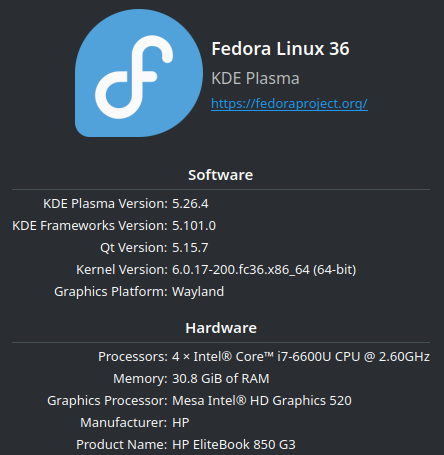Fedora was was real fun but, in the end, after a year, I gave up and moved on.
A couple of things happened:
A few weeks ago, I was installing Linux updates on this here laptop and on a restart things started acting weird. My audio interface was nowhere to be found. My mouse started acting real janky. And apps (mostly DAW) were just crashing randomly.
I didn’t have time to dive in and look so I booted over to my Windows partition and made a note to look into whatever was going on sometime later.
This week, I had decided to trade laptops with my eldest as hers was just not handling the workload anymore. It’s an old, refurbished Dell Latitude that was purchased just before the shutdown in 2020. With it’s fifth gen i5 CPU and 4GB of memory, it was simply no longer up for the tasks she needs it for. I’d backup all the stuff off the HP laptop, (at this point only used as a Plex server) format it, install Windows 10 and then she would have something very workable. Then I’d install Fedora on her old laptop and use it to run Plex.
Getting her setup was a breeze. There were zero hiccups getting the HP back to factory and getting Win10 running and she’s now happily doing schoolwork, playing games, and chatting with friends.
As for the Latitude, Fedora installed easily. Past that, I wouldn’t do the one single thing I wanted it to: run a Plex server.
I simply do not understand why. Plex installed. The Plex service was running. But Plex would not see the mounted external drive nor did it see any folder on the local drive. All the permissions were correct. Everything was showing up in the file manager. I spent hours searching the net for solutions. I tired every command line “fix” that was posted, and there were a lot of potential fixes. I even tried starting fresh by reinstalling Fedora only to wind up in the exact same spot.
I finally just said, “fuck it”.
I formatted that little laptop back to factory (Windows 10). Then I installed Plex, pointed it to a folder and …
It worked.
I went upstairs and tested it on the TV and …
It worked.
So yesterday I said, “fuck it”. I made the decision to flatten this computer back to factory and just move on with Windows.
I just don’t want to fight to use a computer anymore. Windows 11 is actually, surprisingly, really good. It’s stable and you can uninstall and disable all the bloatware and advertising bullshit with a few clicks and it just hums along doing its thing.
I still support Open Source and Independents. While I’m running Windows now, I still run and fully support the applications listed on my “Things I Use” sidebar.
Sadly, Linux just turned out to be a no go for me. I will say that it is absolutely better than it was even a decade ago and I was able to use it as a my primary desktop for nearly a year (and I got to start and finish a song in it!). For me though, it’s still not 100%. So here we are.




